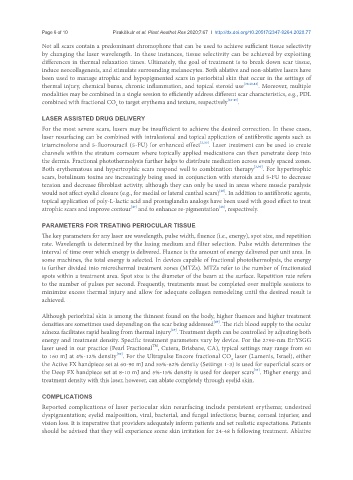Page 792 - Read Online
P. 792
Page 6 of 10 Pirakitikulr et al. Plast Aesthet Res 2020;7:67 I http://dx.doi.org/10.20517/2347-9264.2020.77
Not all scars contain a predominant chromophore that can be used to achieve sufficient tissue selectivity
by changing the laser wavelength. In these instances, tissue selectivity can be achieved by exploiting
differences in thermal relaxation times. Ultimately, the goal of treatment is to break down scar tissue,
induce neocollagenesis, and stimulate surrounding melanocytes. Both ablative and non-ablative lasers have
been used to manage atrophic and hypopigmented scars in periorbital skin that occur in the settings of
thermal injury, chemical burns, chronic inflammation, and topical steroid use [30,40,41] . Moreover, multiple
modalities may be combined in a single session to efficiently address different scar characteristics, e.g., PDL
combined with fractional CO to target erythema and texture, respectively [42-45] .
2
LASER ASSISTED DRUG DELIVERY
For the most severe scars, lasers may be insufficient to achieve the desired correction. In these cases,
laser resurfacing can be combined with intralesional and topical application of antifibrotic agents such as
triamcinolone and 5-fluorouracil (5-FU) for enhanced effect [2,30] . Laser treatment can be used to create
channels within the stratum corneum where topically applied medications can then penetrate deep into
the dermis. Fractional photothermolysis further helps to distribute medication across evenly spaced zones.
Both erythematous and hypertrophic scars respond well to combination therapy [2,30] . For hypertrophic
scars, botulinum toxins are increasingly being used in conjunction with steroids and 5-FU to decrease
tension and decrease fibroblast activity, although they can only be used in areas where muscle paralysis
[46]
would not affect eyelid closure (e.g., for medial or lateral canthal scars) . In addition to antifibrotic agents,
topical application of poly-L-lactic acid and prostaglandin analogs have been used with good effect to treat
[47]
atrophic scars and improve contour and to enhance re-pigmentation , respectively.
[48]
PARAMETERS FOR TREATING PERIOCULAR TISSUE
The key parameters for any laser are wavelength, pulse width, fluence (i.e., energy), spot size, and repetition
rate. Wavelength is determined by the lasing medium and filter selection. Pulse width determines the
interval of time over which energy is delivered. Fluence is the amount of energy delivered per unit area. In
some machines, the total energy is selected. In devices capable of fractional photothermolysis, the energy
is further divided into microthermal treatment zones (MTZs). MTZs refer to the number of fractionated
spots within a treatment area. Spot size is the diameter of the beam at the surface. Repetition rate refers
to the number of pulses per second. Frequently, treatments must be completed over multiple sessions to
minimize excess thermal injury and allow for adequate collagen remodeling until the desired result is
achieved.
Although periorbital skin is among the thinnest found on the body, higher fluences and higher treatment
[49]
densities are sometimes used depending on the scar being addressed . The rich blood supply to the ocular
adnexa facilitates rapid healing from thermal injury . Treatment depth can be controlled by adjusting both
[29]
energy and treatment density. Specific treatment parameters vary by device. For the 2790-nm Er:YSGG
TM
laser used in our practice (Pearl Fractional , Cutera, Brisbane, CA), typical settings may range from 60
[50]
to 160 mJ at 4%-12% density . For the Ultrapulse Encore fractional CO laser (Lumenis, Israel), either
2
the Active FX handpiece set at 60-90 mJ and 55%-82% density (Settings 1-3) is used for superficial scars or
[51]
the Deep FX handpiece set at 8-10 mJ and 5%-15% density is used for deeper scars . Higher energy and
treatment density with this laser, however, can ablate completely through eyelid skin.
COMPLICATIONS
Reported complications of laser periocular skin resurfacing include persistent erythema; undesired
dyspigmentation; eyelid malposition, viral, bacterial, and fungal infections; burns; corneal injuries; and
vision loss. It is imperative that providers adequately inform patients and set realistic expectations. Patients
should be advised that they will experience some skin irritation for 24-48 h following treatment. Ablative

